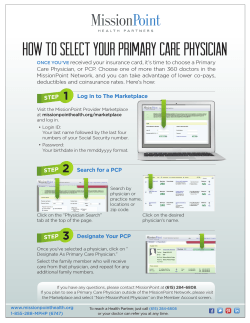
JIM FOODY, MD WHAT IS WRONG? Principles and Concepts of the PCMH
JIM FOODY, MD Principles and Concepts of the PCMH WHAT IS WRONG? • Poor access to care, especially for the uninsured • Escalating costs & volume of services • No link between cost and quality • Excessive administrative costs • Dysfunctional payment system • United States is lagging internationally • Impending “collapse” of primary care Adapted from Michael Barr 1 WHAT IS WRONG? • Poor access to care, especially for the uninsured • Escalating costs & volume of services • No link between cost and quality • Excessive administrative costs • Dysfunctional payment system • United States is lagging internationally • Impending “collapse” of primary care WHAT IS WRONG? • Poor access to care, especially for the uninsured • Escalating costs & volume of services • No link between cost and quality • Excessive administrative costs • Dysfunctional payment system • United States is lagging internationally • Impending “collapse” of primary care 2 GROWTH IN MEDICARE EXPENDITURES 1970-2015 Dollars in billions Source: The Commonwealth Fund; Data from 2006 Medicare Trustees’ Report. WHAT IS WRONG? • Poor access to care, especially for the uninsured • Escalating costs & volume of services • No link between cost and quality • Excessive administrative costs • Dysfunctional payment system • United States is lagging internationally • Impending “collapse” of primary care 3 COMPARING SELECT HEALTH INDICATORS Indicator USA Health care expenditures (per capita) OECD $6401 $2560 Infant mortality (per 100 live births) 6.8 5.4 Life expectancy at 65 20.0 19.5 Pharmaceutical spending (per capita) $752 $363 579 245 Coronary revascularization (per 100,000) Adapted from Emanuel, E. J. et al. JAMA 2008;299:2789-2791. WHAT IS WRONG? • Poor access to care, especially for the uninsured • Escalating costs & volume of services • No link between cost and quality • Excessive administrative costs • Dysfunctional payment system • United States is lagging internationally • Impending “collapse” of primary care 4 ADMINISTRATION Underwriting Risk Adjustment Paperwork Billing and Collecting Claims Management and Denials Multiplicity of Incompatible Systems WHAT IS WRONG? • Poor access to care, especially for the uninsured • Escalating costs & volume of services • No link between cost and quality • Excessive administrative costs • Dysfunctional payment system • United States is lagging internationally • Impending “collapse” of primary care 5 MEDIAN PRETAX COMPENSATION SELECTED SPECIALTIES 2004 10 year change 1995-2004 GIM $168,551 21.0% Invasive Cardiology $427,815 26.9% GI $368,733 75.7% Hematology/Oncology $350,920 85.8% Dermatology $308,855 74.5% Orthopedic Surgery $396,650 31.4% Radiology $406,852 64.4% Urology $335,731 57.5% Adapted from Bodenheimer T, et al. Ann Intern Med. 2007;146:301-306. WHAT IS WRONG? • Poor access to care, especially for the uninsured • Escalating costs & volume of services • No link between cost and quality • Excessive administrative costs • Dysfunctional payment system • United States is lagging internationally • Impending “collapse” of primary care 6 PHYSICIAN SERVICES SPENDING PER CAPITA a a b Source: The Commonwealth Fund, calculated from OECD Health Data 2006. PRIMARY CARE SCORE VS. HEALTH CARE EXPENDITURES, 1997 UK DK SP FIN NTH AUS SWE CAN JAP BEL FR GER US Source: The Commonwealth Fund, Data from B. Starfield, “Why More Primary Care: Better Outcomes, Lower Costs, Greater Equity,” Presentation to the Primary Care Roundtable: Strengthening Adult Primary Care: Models and Policy Options, October 3, 2006. 7 WHAT IS WRONG? • Poor access to care, especially for the uninsured • Escalating costs & volume of services • No link between cost and quality • Excessive administrative costs • Dysfunctional payment system • United States is lagging internationally • Impending “collapse” of primary care Proportions of Internal Medicine Residents Choosing to Work as General Internists, Subspecialists, or Hospitalists, 1998-2007 Okie S. N Engl J Med 2008;359:2305-2309 8 WHAT DO WE NEED? • Superb access to care • Patient engagement in care • Clinical IT to support – High-quality care and quality improvement – Practice-based learning, Care coordination Integrated, comprehensive care Ongoing, routine patient feedback to a practice Publicly available information on practices • • • • Adapted from Davis K, Shoenbaum S, Audet AM: A 2020 Vision of Patient-Centered Primary Care JGIM 2005 WHAT HAS NOT WORKED SO FAR? Primary Care / Gatekeeper Precertification Event-based payment Relative value payment (RVU) Cost shifting uninsured Expanding / Contracting Physician Workforce 9 Stupidity doing the same thing and expecting different results THE JOINT PRINCIPLES OF THE PATIENT- CENTERED MEDICAL HOME Personal physician Physician directed medical practice Whole person orientation Care is coordinated Quality and safety Enhanced access to care Payment to support the PCMH o Coordination Payment o Visit Fee Team-based care: NP/PA RN/LPN Medical Assistant Office Staff Care Coordinator Nutritionist/Educator Pharmacist Behavioral Health Case Manager Community resources DM companies Others… 10 PCMH STANDARDS 1. Access and Communication 2. Patient Tracking and Registry 3. Care Management 4. Patient SelfManagement Support 5. Electronic Prescribing 6. Test Tracking 7. Referral Tracking 8. Performance Reporting and Improvement 9. Advanced Communications "CHANGE IS NOT MANDATORY.” “SURVIVAL IS NOT MANDATORY.” W. Edwards Deming 11
© Copyright 2025











